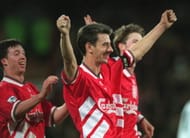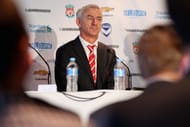“I think Rushie would be the first to admit that in training he just looked like an ordinary player. He didn’t have the explosive pace, but all of a sudden, as soon as he got in the first team, he caught fire. He surprised everybody. He gained three or four yards of pace, his touch was great. His record speaks for itself, what a great player to be replaced by. I feel good about it. I would have felt worse if somebody had replaced me not as good. He wasn’t the best of trainers, but a great, great, great player for Liverpool. A class act.” - David Johnson, former Liverpool striker who was effectively replaced by Ian Rush.
Liverpool FC, being as big a club that they are, have fans who do not confer the title of ‘Legend’ as easily as other clubs and their set of fans might. But the Merseysiders have put Ian Rush in an elevated pedestal, which tends to unscaleability for every player to put on the Red shirt – a distant dream. And that is a perfect testimony to the greatness he has achieved at and with this club.
Early Days at Chester
Ian James Rush started his professional football career at lowly Chester City, a fourth division club back then. The Welshman still remains the single most exciting football talent they have ever produced till the dissolution of the club in 2010. Rush, as he rolls back his years, still believes that his best moment came in a Chester shirt thirty three years back while playing against Newcastle United in a FA Cup tie. Rush scored and helped his team edge past the Magpies 2-0 and also shot himself into superstardom in the process.
Liverpool FC: A compelling romance
Liverpool and Manchester United, both were closely monitoring Rush. And when Bob Paisley came calling for his signature, Rush’s ludicrously high wage demands set the deal off and he stayed on at Chester. But an adamant Paisley came back and after some deliberation over his wage, Rush finally signed for Liverpool. He later had revealed, the hundred pounds a week demand was a ploy to scare off Liverpool as Rush was not sure of his credentials to fit into the side which boasted some big names including the most notable Kenny Dalglish.
As much impossible it may seem now for an 18-year-old to make a switch from a third division side to one of the best clubs in Europe, it did happen back then. But Rush’s rise was far from meteoric as he had to go through the routine Liverpool drill of playing for the reserves and announce his readiness for the first team.
His club debut came as late as December 13, 1980; almost seven months after his arrival at the club. Ipswich Town were posing themselves as a surprise title contender that season which added further importance to the fixture since it would always have a bearing on Liverpool’s success at defending the league title. With number seven Kenny Dalglish out with an ankle injury, Paisley decided to give Rush the big break. However, the childhood Everton fan disappointed in a 1-1 draw and had to once again go back to training with the reserves once Dalglish returned for the following game.
Rush’s relegation to the reserves knocked the wind out of the player and soon he was starting to doubt if he would make the cut at Liverpool. But on hindsight, Rush is always full of praise for the Liverpool system and firmly believes that whatever happened at Melwood training ground helped him become the player he was. However, his patience finally bore fruit as injuries to Steven Heighway and David Johnson manufactured the perfect opportunity for Rush to have a second chance at impressing Paisley and up the claim for a spot. He played alongside Kenny Dalglish in the League Cup final replay which Liverpool won, but despite failing to score he did put in a good performance.
Paisley however, seemed far from impressed as he urged Rush to be more selfish in front of goal. And it is surprising how a simple advice turned Rush into a goal scoring machine, something even hours of training could never have possibly done that. The following season, he finished as the club’s leading scorer with 30 goals helping the club bring the league title back to Anfield and successfully defend the League Cup. Trophies, goals and honors galore as Rush continued to torment defenses around the continent as Liverpool won the League Cup treble in the 1983-84 season as the Reds edged past Roma 4-2 to lift the European Cup. PFA Player of the Year, BBC Wales Sports Personality of the Year and PFA Writers’ Footballer of the Year were the individual honors bestowed upon Rush for the terrific season he had.
Napoli came calling that summer, presenting Rush with the prospect of playing alongside arguably the best player in the world Deigo Maradona and earn a million pounds as well. Rush revealed that the money had unsettled him and he was upset to not have been granted the permission to make the move but he finally made the Italian switch in 1986 when he joined Juventus following the Heysel tragedy.
Heysel Tragedy and the Italian misadventure
In May 1985, as the then European powerhouse Liverpool were trying to retain their crown of being the best in the continent against the Italian might of Juventus, the ‘darkest event in the history of UEFA’ unfolded as 39 fans died and several others were injured following violence between the two sets of fans.
Despite the magnitude of the event, UEFA decided to carry on as anything else would have risked inciting further violence. The Turin side won the match 1-0 as Liverpool failed to hold on to the title and subsequently incurred a 6 year ban from European competitions. The financial loss that Liverpool were staring at due to their barring from European competitions could only be balanced by the sale of Ian Rush to Juventus, who readily pounced on the opportunity to play in the elite competition and test himself against what was considered back then the impregnable Italian defenses.
However, his stint with Juventus had to be delayed by an extra year as Michel Platini decided to retire a year later. So Platini and Michel Laudrup were filling up the foreign quota of two players at the club resulting in Rush being loaned to Liverpool for another season.
Contrary to majority verdict, Rush believed that his only season at Juventus was a success as he went on to score 14 goals against airtight defenses in Serie A. The Italian side were determined to build the team around him and moves for Steve McMahon and Peter Beardsley were made to compliment him in the team. However, Kenny Dalglish turned the offers down from the Turin club as he was more intent on bringing him back to the club than losing any more of his top players to another club.
Rush’s ‘My Italian Diary’ reflects upon the lifestyle he had there and how difficult it was for him to get adjusted to the Italian way of football. However, he later confessed to have improved during his stay as he became defensively more responsible while playing for Juventus.
Liverpool – The comeback
“Rushie is back”, screamed the Anfield faithful as a closely guarded secret was finally revealed to the fans. Despite the Heysel tragedy, the astonishingly good relations between Liverpool and Juventus came to the forefront as the entire deal was wrapped up over phone by Kenny Dalglish. Rush’s departure had seen Liverpool roping in John Aldridge as a replacement. And with John in great goalscoring form, Rush had to find himself on the bench more often than not.
April 15, that season, the FA Cup semi-final between Liverpool and Nottingham Forest witnessed perhaps the worst possible stadium disaster in British history as 96 fans died in the crush at the Hilllsborough stadium. When Ian Rush scored an extra time brace, against bitter rivals Everton to win the FA Cup, it was a fitting tribute to the people who lost their lives.
Rush’s final League title came in the 1989-90 season, interestingly Liverpool’s 18th and they have not won another till date as Manchester United, under Sir Alex Ferguson, established themselves as the ultimate force in the country. Rush, however, continued to score freely even the season after that but despite once again ending with a season tally of 26 goals, Liverpool failed to win any silverware. But with the reinstatement in the European competition after having served a six year ban, Liverpool fans and players quickly pushed aside the disappointment of the previous season.
With every passing season, Rush was starting to lose his goalscoring touch that made him the player he was. He lost out on his speed which affected his goalscoring in turn. Rush started the 1995-96 season as their first choice striker alongside Stan Collymore but eventually surrendered his place to the young, talented Robbie Fowler.
Rush bade farewell to Liverpool in 1996 summer when he left for Leeds United after having scored 346 goals for the club and his record stands till date as the highest ever goal scorer for Liverpool.
Those were the glory days of Liverpool when Ian Rush used to more often than not catapult the side into wins and trophies season after season. But ever since his retirement, Liverpool have failed to produce as good a striker as Rush. Everytime the club bring in a new number nine, he will be compared to him evidently. ‘He is no Ian Rush’ is being heard among the Merseysiders since forever. But the man with a moustache, the man who was referred to as a cross between Charlie Chaplin and Adolf Hitler back in Italy, remains optimistic that the glory days of the club would be back soon.
You Will Never Walk Alone, Ian.


